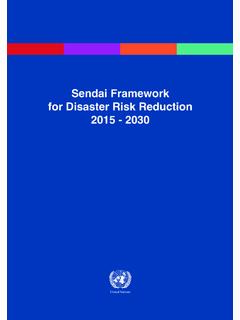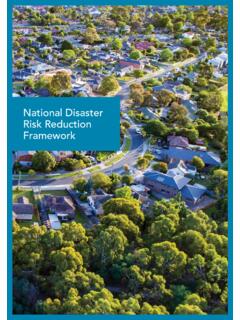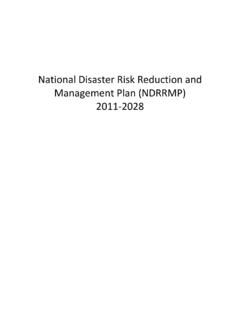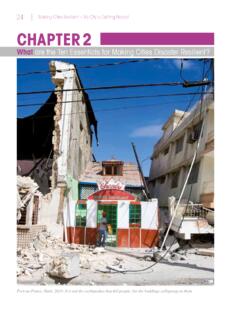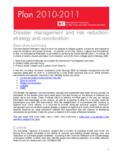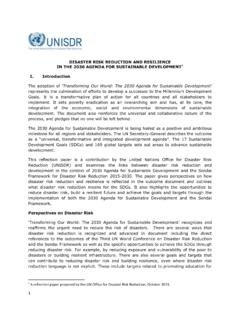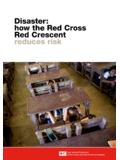Transcription of Resilient Livelihoods: Disaster Risk Reduction for Food ...
1 2013 EDITIONFOOD AND AGRICULTURE ORGANIZATION OF THE UNITED NATIONSRome, April 20132013 EDITIONU pdated new editionFirst edition 2011 Recommended citationFAO. 2013. Resilient livelihoods Disaster Risk Reduction for Food and Nutrition Security framework : FAO/O. AsselinBack-cover Left: FAO/T. Brekke; Centre: FAO/Y. Chiba; Right: FAO Page 1: FAO/S. RamasamyPage 4: FAO/Sean GallagherPage 13: FAO/D. ChattyPage 17: FAO/S. Wabbes-CandottiPage 19: FAO/A. VitalePage 27: FAO/I. VelezPage 29: FAO/G. NapolitanoPage 31: FAO/Bangladesh Field TeamPage 37: FAO/ Sean GallagherPage 39: FAO/G. TortoliPage 49: FAO/G. NapolitanoPage 56: Mongolia, Ovorhangay Province Office 2010 Page 57: FAO/Simon MainaPage 59: FAO/G. NapolitanoPage 65: FAO/F. McDougallPage 67: FAO/A. VitalePage 68: FAO/G.
2 NapolitanoPage 73: FAO/I. VelezPage 79: FAO/Bangladesh Field TeamThe designations employed and the presentation of material in this information product do not imply the expression of any opinion whatsoever on the part of the Food and Agriculture Organization of the United Nations (FAO) concerning the legal or development status of any country, territory, city or area or of its authorities, or concerning the delimitation of its frontiers or boundaries. The mention of specific companies or products of manufacturers, whether or not these have been patented, does not imply that these have been endorsed or recommended by FAO in preference to others of a similar nature that are not views expressed in this information product are those of the author(s) and do not necessarily reflect the views or policies of 978-92-5-107624-8 (print)E-ISBN 978-92-5-107625-5 (web)FAO encourages the use, reproduction and dissemination of material in this information product.
3 Except where otherwise indicated, material may be copied, downloaded and printed for private study, research and teaching purposes, or for use in non-commercial products or services, provided that appropriate acknowledgement of FAO as the source and copyright holder is given and that FAO s endorsement of users views, products or services is not implied in any requests for translation and adaptation rights, and for resale and other commercial use rights should be made via or addressed to information products are available on the FAO website ( ) and can be purchased through FAO 2013v FOREWORDvii ACKNOWLEDGMENTS viii EXECUTIVE SUMMARY1 INTRODUCTION17 SCOPE OF THE FRAMEWORK29 THE FOUR THEMATIC PILLARS31 PILLAR 1 - ENABLE THE ENVIRONMENT39 PILLAR 2 - WATCH TO SAFEGUARD49 PILLAR 3 - APPLY PREVENTION AND MITIGATION MEASURES59 PILLAR 4 - PREPARE TO RESPOND67 DRR AND CLIMATE CHANGE ADAPTATION73 HARNESSING GLOBAL ACTION79 IMPLEMENTATION ARRANGEMENTS85 ANNEXES86 ANNEX I - Synergies between DRR and climate change adaptation for FNS88 ANNEX II - Acronyms89 ANNEX III - GlossaryvFOREWORDD isasters and food insecurity are directly interconnected.
4 Floods, hurricanes, tsunamis and other hazards can spoil food, destroy agricultural, livestock and fishing and food processing infrastructure, assets, inputs and production capacity. They interrupt market access, trade and food supply, reduce income, deplete savings and erode livelihoods . Drought, plant pests and diseases such as locusts and armyworms, animal diseases like African swine fever, and food contamination or adulteration have a direct economic impact by reducing or eliminating farm production, by adversely affecting prices, trade, and market access and by decreasing farm income and employment. Economic crises such as soaring food prices reduce real income, force the poor to sell their assets, decrease food consumption, reduce their dietary diversity and access to safe and quality food.
5 Disasters create poverty traps that increase the prevalence of food insecurity and these reasons, Resilient livelihoods are critical to the efforts of the Food and Agriculture Organization of the United Nations (FAO) to help the world s most vulnerable people achieve food security and the freedom from hunger one of the most basic human rights. At FAO, Disaster risk Reduction is about protecting people s livelihoods from shocks, and strengthening their capacity to absorb the impact of, and recover from, disruptive events. Disaster risk Reduction is a necessary ingredient for food and nutrition security, and for the achievement of the Millennium Development Goal responded to the recommendations made by its governing bodies by developing a Disaster Risk Reduction for Food and Nutrition Security framework Programme.
6 It expresses FAO s corporate commitment to reducing risks and building livelihood resilience thus protecting development gains. It aims to scale-up and accelerate actions for Disaster risk Reduction at local, country, regional and global levels, building on FAO s existing technical capacities as well as on Disaster risk Reduction initiatives and good practices FAO Disaster Risk Reduction for Food and Nutrition Security framework Programme aims to provide strategic direction to the implementation of Disaster risk Reduction measures in member countries across the agricultural-related sectors in line with the Hyogo framework for Action and its five priority areas. In addition, it promotes an inter-disciplinary and programmatic approach to Disaster risk Reduction for food and nutrition security, by integrating the agriculture, livestock, fisheries, forestry and natural resource management sectors, to respond more effectively to the diverse livelihoods of small-scale farmers and to the complex set of factors which contribute to Disaster intent is that this framework Programme will help generate greater understanding.
7 Interest and action in Disaster risk Reduction for food and nutrition Muller Laurent ThomasAssistant Director-General Assistant Director-GeneralNatural Resources Management Technical Cooperation Department and Environment DepartmentviviiACKNOWLEDGEMENTSThis Disaster Risk Reduction for Food and Nutrition Security framework Programme of the Food and Agriculture Organization of the United Nations (FAO) is the result of a joint effort led by the FAO Natural Resources Management and Environment Department and the FAO Technical Cooperation Department. In addition, it has been made possible by the inter-disciplinary effort and cross departmental collaboration of the Economic and Social Development Department, Agriculture and Consumer Protection Department, Fisheries and Aquaculture Department, Forestry Department, Office of Knowledge Exchange, Research and Extension, FAO decentralized offices and FAO Emergency and Rehabilitation Coordination s Interdepartmental Technical Team on Disaster risk Reduction , established under FAO s Strategic Objective for Disaster and crises management in 2009, played an instrumental role in, and provided strategic guidance and technical contributions to, the development of this framework Programme.
8 In particular, we wish to thank Shukri Ahmed, Cristina Amaral, Philippe Ankers, Stephan Baas, David Brown, Mona Chaya, Peter Kenmore, Thomas Muenzel, Lucia Palombi, Christian Pantenius, Florence Poulain, Pieter VanLierop and Sylvie Wabbes-Candotti for their direct contributions and extensive participation in technical support and constructive feedback was also received from many FAO colleagues, including Mario Acunzo, Federica Battista, Marta Bruno, Elizabeth Christy, Eve Crowley, Florence Egal, Theodor Friedrich, Thomas Hofer, Peter Holmgren, Patrick Jacqueson, Josef Kienzle, Laura Meza, Jennifer Nyberg, Emmanuella Olesambu, Thomas Osborn, Selvaraju Ramasamy and Jan development of the Disaster Risk Reduction for Food and Nutrition Security framework Programme was made possible with the overall guidance, coordination and process facilitation provided by Cristina Amaral, Stephan Baas and Sylvie Wabbes-Candotti, and Monica Trujillo as coordinating lead SUMMARYThe multiple threats to food and nutrition security, their negative and cumulative impact, and the clear link between shocks and hunger reveal the fragility of current food production systems and their vulnerability to its Disaster risk Reduction (DRR) activities, the Food and Agriculture Organization of the United Nations (FAO)
9 Seeks to protect livelihoods from shocks, to make food production systems more Resilient and more capable of absorbing the impact of, and recovering from, disruptive risk Reduction protects development investments in the agriculture, livestock, fisheries/aquaculture and forestry sectors, helping the world s most vulnerable people become food secure. Disaster risk Reduction is vital for ensuring one of the most basic human rights the right to food and freedom from hunger. Furthermore, Disaster risk Reduction creates a multiplier effect that accelerates the achievement of the Millennium Development Goal 1: the eradication of extreme poverty and FAO, Disaster risk Reduction and management is a corporate priority. It is expressed in FAO s Strategic framework 2010-19, and further elaborated through Strategic Objective 5 Increase the resilience of livelihoods to threats and FAO Disaster Risk Reduction for Food and Nutrition Security framework Programme (DRR for FNS) serves to support and provide strategic direction, to FAO member countries and partners, for the implementation of Disaster Risk Reduction for Food and Nutrition Security FAO Disaster Risk Reduction for Food and Nutrition Security framework Programme reflects the Hyogo framework for Action and strives to assist member countries implement the five Priorities for Action in the Hyogo framework for Action in the agricultural sectors.
10 It also responds to recommendations made on Disaster risk Reduction in 2010 by the Committee on Agriculture, the Programme and Finance Committee, the Committee on World Food Security and the Committee on Fisheries. It contributes to meeting the needs of member countries, as expressed in the Regional Areas of Priority Action and identified by FAO Regional Conferences held in goal of the FAO Disaster Risk Reduction for Food and Nutrition Security framework Programme is to enhance the resilience of livelihoods against threats and emergencies to ensure the FNS of vulnerable farmers, fishers, herders, foresters and other at risk the framework Programme supports national government partners, the direct beneficiaries are smallholders in developing countries, including small-scale farmers, fishers, pastoralists, foresters and the urban poor particularly women whose lives and livelihoods are threatened.










